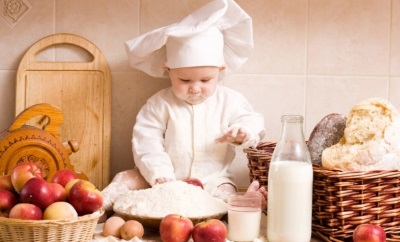Pedagogical lure during breastfeeding
An older child needs more nutrients than his mother's milk or formula provides. That is why, from the age of 6 months, WHO recommends starting the introduction of complementary foods - food, which will eventually replace breast or artificial feeding.
Doctors have developed and offer parents the optimal scheme for the introduction of different groups of products in the children's diet. However, there is another way to introduce the baby to the food that adults eat. It is called pedagogical lure. Let's see what this kind of food is different from the traditional one and how to introduce it.
pros
- Acquaintance of a child with a new food takes into account the needs, maturity of the baby and his desires.
- During family meals, the infant learns the traditions of its family related to eating.
- Mom does not need to spend time on a separate preparation of any dishes for crumbs.
- Pedagogical supplements do not harm breastfeeding mother's milk.
- Peanut learns to chew, and its digestive system gradually gets used to new dishes.
- With such a lure problems with appetite in children, as a rule, does not happen.
- No need to buy baby jars of mashed potatoes and cereal in boxes.
Minuses
- Scientific basis for the introduction of such foods does not exist.
- It is very difficult to find out which product caused allergies or upset stools.
- At the first sample, the baby may choke on food.
- The whole family should start eating right, eliminating fried, smoked, salty and spicy dishes. However, this minus soon turns into a plus for all family members.
About what is pedagogical supplement, see the transfer of Dr. Komarovsky.
Calculate your own table for traditional foods You can by filling out the form below.
When can I start?
Baby begin to offer pedagogical supplements, taking into account the physiological and psychological development of the crumbs. In this case, according to the recommendations of physicians, up to 6 months of age, no food other than breast milk is given to a child.
Some babies are ready to try the food from the mother's plate at 6 months, others - at 7 or even later, that is, the beginning is completely individual.
When and where to start?
Pedagogical supplements do not aim to saturate the crumb with new food and force out breastfeeding with new dishes. Starting this type of food is advised if available:
- Physical readiness. The kid already knows how to hold objects in his hand, as well as bring a spoon to his mouth. When food gets into the mouth of a toddler, it is not pushed out by the tongue. In this case, the child's jaws make chewing movements.
- Nutritional interest. The baby is constantly interested in the food in the plates of other family members, as well as cutlery.
- The physiological readiness of the gastrointestinal tract. When a baby tries a new product, it does not develop vomiting, thinning of the stool or an allergic reaction.
Before giving the child the first micro-nutrition of a new food, the infant is introduced to the rules of behavior in the kitchen. Mom takes the baby for a family breakfast or dinner, and also cooks next to the child.
Pedagogical supplements are introduced as follows:
- Mom puts on her plate fresh, tasty and safe baby food.
- Baby sits on mom's lap, holding his spoon in the handle.
- When the mother begins to eat, the baby begins to show interest in the contents of the mother's plate.
- As soon as the toddler reaches for food, the mother treats the baby with a micro dose of one of the products. So called a tiny portion of the size of a grain of rice or a match head. For liquid products, such a micro dose is one sip.
- Baby eats product or spits it out.
- If the child liked the dish, they give it up to two more microscopic portions of the same dish.
- Within 3-5 days, the product you like can continue to be given in an amount of not more than three micro doses.
- Further, in the absence of negative reactions of the child's body to a new food, the amount of the product is increased to a teaspoon.
Rules and principles
- Introduction of pedagogical complementary foods is not subject to a clear calendar. The main aspect for the start of such foods is the crumbs' willingness to try unfamiliar food.
- The consistency of dishes that a child tastes does not change. The babies are given food in the same form in which their parents eat, rather than preparing mashed potatoes.
- For the child is not prepared separately. To comply with this and previous principles, the family must adhere to a healthy diet. On the plates of parents should be dishes from cereals, vegetables, dairy products, meat, fish. You should not offer the child sweets, fried, sausage.
- While the baby has not learned to hold a spoon, he receives food from the parental plate, sitting on his mother's lap. From about 9 months of age, the baby can be seated in his chair, and the food for him can be put on his separate plate.
- The baby continues to breastfeed. If the child is fed a mixture, then pedagogical supplements are not recommended. One of the goals of introducing pedagogical supplements is to support HB for up to a year or longer. The child, trying new products, receives valuable nutrients from mother's milk, washing them with food from an adult's plate.
- Encouraging karapuz interest in food, the crumbs are simultaneously taught to the correct behavior at the table. It is not necessary to allow the child to be ugly on a plate. If the baby begins to active, the mother should move the plate away or cover it.
- The child should be offered food that interested him. We should not insist that the little tot would try the food that was not interesting to him.
- If the child really liked some dish, then it should be given no more than 1-2 times a week, so as not to disrupt the process of dating toddler with other food.

Signs of improper introduction of complementary foods
Difficulties familiar with adult food are many babies. Regarding pedicure, they conclude that after sufficiently successful trials and a good appetite, the child begins to refuse to eat. This is a sure sign of overeating, so do not take a crumb along with you to the table for a few days to solve the problem. If the child at this time again showed interest in the food of the parents, it is not worth hindering the crumbs. In addition, it is desirable for the little one to eat with an appetite, and show how you like the products on the plate.
Opinion E. Komarovsky
The famous pediatrician does not see any harm in pedagogical prikorm, but does not consider it useful either. Komarovsky is sure that children’s acquaintance with vegetables, meat, cereals, kefir and other products is best carried out according to the traditional feeding introduction scheme, which is more common and supported by pediatricians.The popular doctor considers such a scheme to be safer and more convenient, and peddorkorm refers to ways of parental entertainment. See the next video for more details.





























































